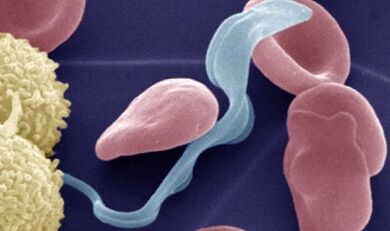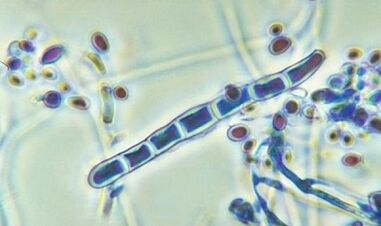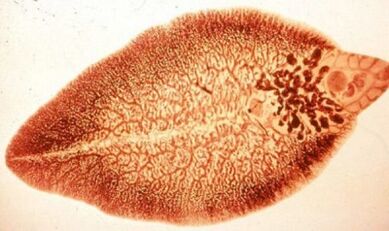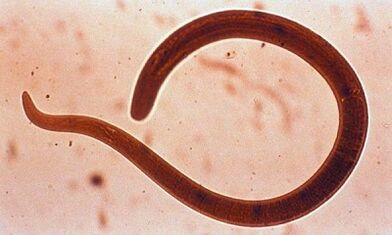Human parasites can live in any organ system. The vital activity of helminth samples can be a prerequisite for the development of cancer, and microscopic fungi and mites lead to allergies.
The human body can be home to at least 300 parasitic species, including bacteria, viruses, protozoa, microscopic fungi, helminths (parasitic worms), and some arthropods. These organisms not only consume nutrients assimilated by the host, but also poison them with the products of their vital activity. In accordance with the canons of modern medicine, the concept of "parasite" does not apply to prenuclear (prokaryotic) organisms: bacteria and viruses. It is characterized by protozoa, fungi, worms, and arthropods that live exclusively in the host.
Microparasites

Human and animal organisms are a fertile environment for the life of microscopic fungi as well as protozoa. They are not visible to the naked eye, they damage the skin and internal organs.
Parasitic protozoa
A infection caused by a protozoan is called a protozoan. Such diseases are widespread in the tropics as well as in temperate latitudes. About 50 protozoan species parasitize in human organs and tissues. They can be infected through sexual contact, food, or insect bites.
Giardiasis is very common. Up to 40% of children and 10% of adults have such pathology. The small habitat of lamblia is the small intestine. The disease can be associated with indigestion and allergic reactions, although it is often asymptomatic. The pathogen is transmitted through food - unboiled water and contaminated food.
According to various sources, 30-50% of the world's population is infected with toxoplasmosis. Its pathogen often lives in the host's body without any clinical manifestations. Toxoplasma poses the greatest danger to pregnant women: it causes intrauterine fetal death or severe developmental disorders. Infection occurs through contact with domestic mammals (cats, rabbits, rodents) and consumption of raw meat.
The most common sexually transmitted infection is the protozoal. This is trichomoniasis. Every year, more than 150 million people are infected worldwide. Manifestations of the disease are determined by which organs are involved. In women, Trichomonas lives in the vagina, causing inflammation accompanied by urethritis. In men, protozoan affects the prostate gland, testicles, and in severe cases leads to prostatitis, although the infection is more often asymptomatic.
Diseases such as malaria, leishmaniasis, Chagas disease, and sleeping sickness are widely known in tropical regions. Their pathogens are plasmodia, leishmania and trypanosome. Parasites are carried by blood-sucking insects: mosquitoes, snails, triatoma beetles. The pathogens of these diseases are acquired and distributed by biting sick animals or humans.
Parasitic fungi

About 100 species of fungi are known to be quite dangerous to humans. Their optimal habitat is the hot and humid areas of the body, such as the interdigital spaces. However, these organisms can also infect the skin and other areas of the human body.
Fungi of the species Trichophyton, Microsporum, Epidermophyton cause dermatomycosis: ringworm and pityriasis versicolor, lesions of the feet, scalp, rarely mucous membranes. Pathogens of these diseases can also be transmitted from animals or patients to humans. In severe cases, bacterial infections are associated with dermatomycosis.
Molds and their spores are no less harmful to humans. They cause diseases such as:
- penicellosis;
- mucosis;
- aspergillosis.
These conditions are characterized by inflammation of all parts of the respiratory system, otitis media and various allergic reactions without exception. In severe cases, parasitic fungi cause pneumonia as well as bronchial asthma. Weakened immunity and chronic diseases are most susceptible to fungal infections.
Beads
The favorite habitat of parasitic worms is the digestive system of humans and animals, in which the host feeds on digested food, bile, and blood. All helminths belong to the following classes:
- globular worms (nematodes);
- flatworms (tapeworms and spots).
Flat parasitic worms
Eggs and larvae of trematodes (flatworms) most often enter the human body with raw water, unwashed greens, and under-cooked meat and fish. Thus:
- liver;
- Chinese
- giant;
- spear flukes;
- cat beetle.

Sometimes humans become infected through direct contact: the larvae of tropical parasites of schistosomes pierce the skin of those swimming in freshwater and then enter the bloodstream in which they live and feed on red blood cells.
Most trematodes affect the liver, gallbladder, and the ducts of these organs, causing diseases - trematodes. The environment of the lung plate is the muscles, the adipose tissue under the skin, the brain, but above all the lungs. The disease caused by this helmin is called paragonimiasis. The small trematode metagonium lives in the small intestine, leading to metagonimiosis.
They are fleetingly small — their flat, leaf-shaped bodies do not exceed 10 cm — but the consequences of their presence in the bodies of animals and humans are fatal. Long-term parasitization of these helminths can lead to cancer, cirrhosis, and gallstone disease.
Unlike trematodes, the body of cestodes can reach tens of meters. The main route of infection with cestodes is food. These helminths get into the human body with raw meat and fish. The main environment for the formation of cestodes is the small intestine, in which adult worms live, while larval forms live in parenchymal organs (liver, lungs, spleen).
The most common of all tapeworms:
- bullish tapeworm;
- echinococcus;
- wide ribbon;
- porcine tapeworm;
- alveococcus.
Round parasitic worms
Diseases caused by parasitic globular worms - nematodes - rank first among all helminthiasis in terms of frequency of development. Most adult parasites inhabit the intestines, but at certain stages of their lives they can migrate to the muscles, lungs, heart, and throat. The following nematodes are prevalent in the human population:

- pinworms;
- globular worm;
- toxin carts;
- Trichinella;
- hookworms;
- Strongylids.
Roundworm eggs and larvae enter the human body through food and water. Nematodes such as hookworms and strongyids themselves penetrate the host's body. These helminth patterns are found primarily in the tropics.
The ubiquitous nematodes are pinworms, roundworms, and toxocars. The former most commonly affect children, causing enterobiasis - the most common helminthiasis. Dogs are carriers of Toxocara, although these nematodes can infect humans. Roundworms live in humans and are not dangerous to most animals except pigs.
Arthropod parasites
Cestodes, trematodes, and parasitic nematodes are designed to live in the internal organs of their hosts. In contrast, most parasitic arthropods live on the surface of the body. Most often, a person is infected with lice and mites, which are the pathogens of demodicosis and scabies. These parasites are dangerous because they can carry pathogenic bacteria and rickettsia that cause Volyn fever, typhus, and relapsing fever.
Lice drink human blood and parasitic mites live on human skin. Scabies itching chews the passages in it, the demodex lives in the hair follicles and ducts of the sebaceous glands. The vital activity of these parasites leads to allergies, accompanied by rash, redness and itching.
The world we live in is evolving rapidly, living standards are constantly rising, and many people today seem to have parasitic diseases in many third world countries. However, population migration leads to the spread of such diseases beyond natural foci. In this regard, it is important to remember the basic rules of hygiene, adherence to which will help to avoid infection.
























